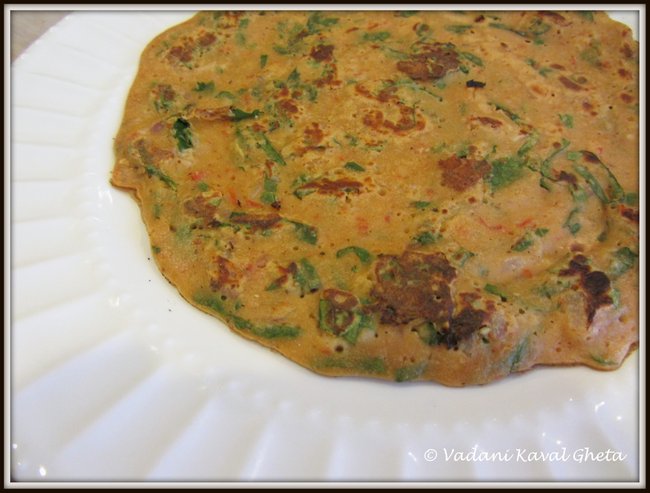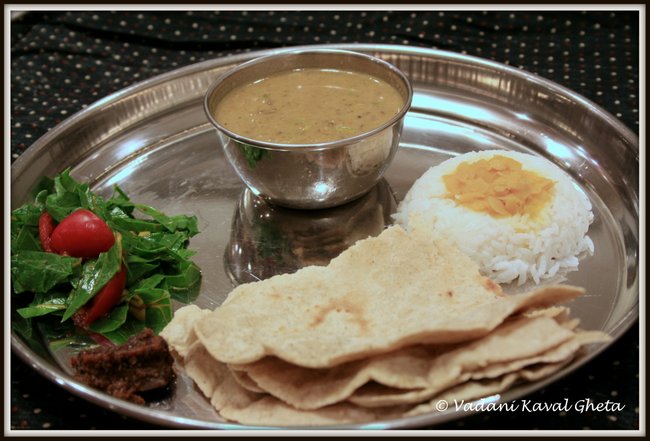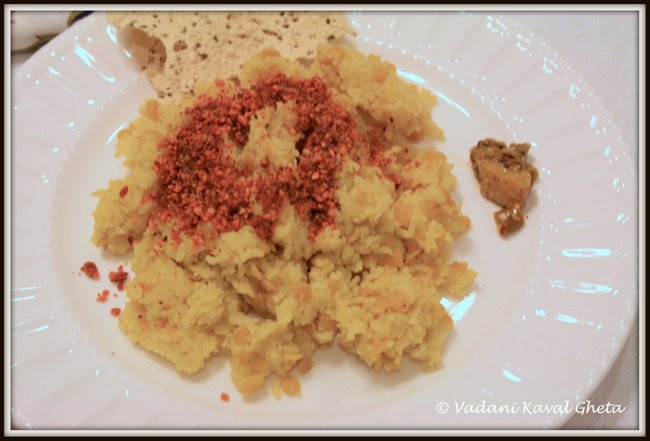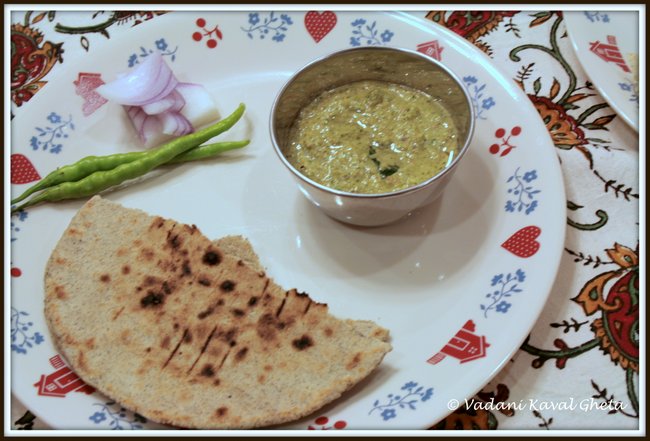Khandeshi Recipes
Today we have Minoti (aka Mints) of Vadani Kaval Gheta share her insight into Khandeshi (a regional cuisine of Maharashtra) food culture. Vadani Kaval Gheta is run by Minoti, an Indian food blogger based in the US. Do visit Minoti’s lovely food blog which focuses on the age old customs and food traditions of the Maharashtrian people. She blogs primarily about vegetarian and vegan cooking and her blog is a treasure house of traditional Maharashtrian cuisine. Thank you, Minoti, for taking time to share with us your regional food cuisine! Dear readers, please give a warm welcome to Minoti.
I am fortunate to have married a wonderful person who is a proud and good cook from Khandesh. Khandesh is near Bhusawal railway junction consisting of Jalgaon, Dhule and Nandurbar districts in Maharashtra. Two different dialects of Marathi kalled Khandeshi and Ahirani are the spoken languages of this region. There is a saying in Marathi “Language changes every 10 milesâ€; I want to adapt that to say “Cooking style changes every 10 miles†too.
Until I went to my in-law’s place, I did not have much idea about Khandeshi food except a sabji here and a chutney there. I fell in love with the cuisine at the first bite! It was very different to what I was used to eating and cooking. I started learning to cook those recipes from my mother-in-law, sister-in-law, husband and even my father-in-law. There were times I would make phone calls to India to ask details about a recipe. Even now I call to check and clarify various recipes with them.
All regions of India generally serve four types of thalis – breakfast thali, everyday lunch thali, every day dinner thali and festival special thalis and Khandesh is no different than the others. Today I am going to share some vegetarian thalis and Khandeshi recipes.
Breakfast thali is not an everyday affair but is served mostly on weekends. Like other Maharashtrian households pohe, upma, left over bread bhaji are made regularly. Mugache dhirade (moong cheela), is moong daal flour mixed with ginger-garlic paste and made into small crepes. Jowar crepes is another traditional breakfast dish. Here’s a picture of Moong dhirade/chila
Another favorite breakfast dish is Methiche parathe and chutney. These are very different from Punjabi style Methi Paratha and Gujarati style Methi Thepala.
Everyday lunch thali is served in a stainless steel plate called taaT/thali. Chapati/wheat roti or Jowar/Sorghum roti is a must. Curry like subji served in a small steel bowl usually in the center of the plate. Chutneys, pickles, salads served on the left side and dry subji on the right hand side. Here is a picture of a simple Khandeshi thali –
Khandeshis love subjis with gravy. Gravies are made with daals and peanuts. These gravies taste very different from the tomato based gravies. Green tomato bhaji with peanut gravy, fenugreek bhaji with peanut gravy are staples. Sometimes pumpkin sabji also takes the center stage. Daal Gandori is another of Khandesh favorite sabji. It is made with green sorrel leaves and green chilies. There are seasonal vegetables like Ghol (Purslane), Chival (very similar to purslane but is bit sour and has smaller leaves.) Stuffed eggplants also appear regularly on the lunch plate. Dry moong daal fry is made when there are no fresh vegetables in the market. Ridge gourd sabji, stuffed baby bitter gourds, Bhindi/Okra sabji are some other vegetables made regularly. Sprouted moong, moth beans are made during summer and rainy season when farmers cannot grow vegetables.
Few chutneys like Green chutney(recipe follows), Nistyachi Chutney make a regular appearance in daily meals. Dry peanut chutney is also staple and easy to make. It is a must for dinner.
Everyday dinner thali is as simple as it can get. Rice-daal khichadi, dry peanut chutney with oil and some leftovers from the morning meal. Khandeshi people love their khichadi.
It is very simple to make – 2 parts rice, 1 part mung daal or toor daal cooked with 2-3 parts water with pinch of turmeric and salt to taste. This khichadi is made over the stove top on low heat. They do not like their kichadi to be mushy so it is never made in pressure cooker. Here is how the everyday dinner thali looks –
Lets see some Khandeshi special thalis –
1. Wedding Thali: One might think the wedding thali must be very elaborate and will showcase something special for the occasion. In Khandesh, wedding invitations go out to almost everyone you know so wedding thali is kept very simple. Chapatis are made a day earlier so can be crumbled easily on the wedding day. One or two chapatis are served per person to crumble. Then make a well with these crumbles, to use as a bowl for plain daal called varan with little bit of ghee/toop. Then everything is mixed and eaten with eggplant bhaji.
2. Shev-Bhaji: Red spicy curry made with bhavnagari gathia. It is served as lunch with chapati. Onion slices and lemon are must accompaniments. Some restaurants do serve it but it is also made at home fairly regularly.
3. Vangyache Bharit (Khandesh style baingan Bharata) and Puri: Khandeshis love their eggplants in any form, so much so that even mentioning this name to Khandeshis make them want to have it right away even after full stomach. I have tried to capture photo feature of the whole process of making Khandeshi special Baingan Bharta.
4. Vafole/muthe/bhendake with kadhi: Steamed toor daal dumplings with kadhi. Buttermilk kadhi is made in earthen pot and tempered using chili-garlic-ginger paste and lichen over live fire.
5. Batti-varan: It is very similar to daal baati of Rajasthan but still very different. Battis are roasted on coal fire. It is enjoyed with simple accompaniments like Amsool Kadhi and Eggplant Bhaji.
6. Upavasachi Thali (Religious fasting thali): Sabudana Khichadi, fried sago/sabudana chakali, sabudana papad adorn the thali. But speciality of Khandesh is Raw Banana Roti with yogurt. Pancakes made with raw banana flour + Amaranth flour and some potatoes make special appearance in fasting thali.
Today, I am going to share a special bread/roti called Bhakari it is made all over Maharashtra including Khandesh. Bhakari is usually made with Jowar/Sorghum flour but Khandeshis make special bhakari called KaLaNyachi Bhakari. It is accompanied by Nistyachi Chutney (red chutney), green chutney(recipe follows), dried gongura bhaji, papadacha Khula, palebhajicha khula (recipe follows) and plain white rice and varan.
Here is how the thali looks –
KaLaNyachi Bhakari:
KaLaNa flour is made by grinding 5 parts Jowar/Sorghum, 1 part whole Urad and salt. Sometimes fenugreek seeds are added to the mix to give it a different flavor. We do not have flour mills in US so I get some from India or I mix store bought jowar/sorghum flour and store bought urad daal flour in the same proportions(5:1), add pinch of salt and mix well. If I have fenugreek/methi flour I add teaspoon to the mix.
Let us move on to making bhakri. Making bhakari needs a little skill but is not difficult. Here is the video I made to share the whole process with all of you –
Note: The video is for simple sorghum/jowar bhakari. The only change for KaLaNa bhakari is use of tap water instead of boiling water to knead the dough. These bhakaris are best when you enjoy them with Green Chutney with Peanuts! Here is how the green chutney is made:
Green Chutney Recipe:
This is the most favorite accompaniment with KaLaNyachi Bhakari in our household. This is again showcases Maharashtrian’s favorite nutty legumes – Peanuts! Lightly roasted peanuts give it a creamy texture.
1 cup Peanuts (not roasted)
6-8 Green Chilies (per taste)
3-4 Cloves of Garlic
2-3 cups Cilantro
1†blob Ginger
Salt per taste
Water as needed
For Tempering – 2-3 tbsp Oil, 1 tsp Cumin Seeds, 10-12 Curry Leaves, Pinch of Hing
Preparation –
Lightly roast peanuts and set aside.
Lightly roast green chilies and cloves.
Coarsely chop cilantro and ginger.
Let everything cool down for 5-10 minutes
Add roasted peanuts, roasted garlic and chilies, chopped ginger and cilantro to wet grinder. Add salt and little water.
Grind into fine paste using little water at a time. This is not a very dry chutney but not liquidy either. Adjust salt if needed.
Heat oil in a small kadhai, add cumin seeds and curry leaves. Let it sizzle for a minute, then add hing. Mix together and pour chutney. Serve in a small bowl and add about ½ tbsp oil and enjoy with KaLaNa bhakari.
Another simple accompaniment is chopped green salad called Khuda. All the available greens are chopped together to make this. Here is how they make it at our place –
Palebhajicha Khuda Recipe (Chopped green vegetable salad)
Mix together chopped fenugreek/methi leaves, green sorrel leaves, tender radish leaves, chopped tomatoes, salt, oil, red chili powder. Squeeze lime juice and mix. Serve as side dish or salad.
Regional food is very hard to capture in one small article and I am not claiming that I have covered everything here. My knowledge of Khandeshi food is fairly recent and I am still learning and getting to know. I learn something new in every India trip and try to replicate that in my kitchen here. I hope you enjoyed reading and will enjoy making these traditional recipes as much as I do.
Thank you Sailu for giving me opportunity to write for such a popular traditional thali series, Indian food trail.
Listed below are guest posts on different Indian regional cuisines by fellow bloggers.
Maharastra
A Simple Summer Meal by Nupur of One Hot Stove
Traditional Maharashtrian Thalis – Veg & Non-Veg by Meera of Enjoy Indian Food
Traditional Maharastrian Sweet & Snacks by Meera of Enjoy Indian Food
Konkan Region – North Canara
An Essay on Konkani Cuisine by Shilpa of Aayis Recipes
Kerala
Munchies from a Kerala home – Shn of Mishmash
A traditional Malabar meal ~ Shaheen of Malabar Spice
Udupi-Mangalore
Exploring Udupi Mangalorean Street Foods by Sia of Monsoon Spice
Mangalore
Mangalore Cuisine, Mangalore Recipes and Mangalorean Catholic Cuisine by Shireen of Ruchik Randhap
Tamil Nadu
Traditional Tamil Tiffins – Lakshmi of Veggie Cuisine
Bengal
Bengali Cuisine ~ Sandeepa of Bong Mom’s Cook Book
Hyderabad
Hyderabadi Cuisine ~ Mona of Zaiqa
Kongu
Kongu Cuisine ~ Indhu of Daily Musings
























